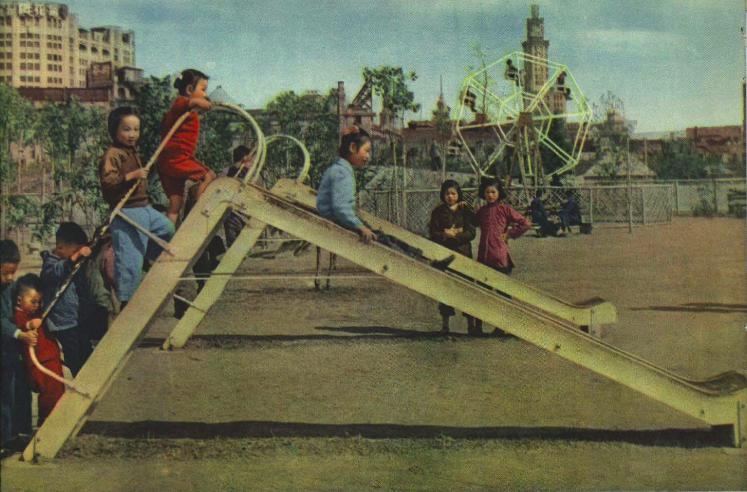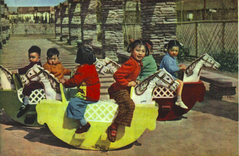
People’s Park Shanghai: Visiting Hours, Tickets, and Travel Guide
Date: 14/06/2025
Introduction: The Legacy and Vibrancy of People’s Park
Nestled in the heart of Shanghai’s Huangpu District, People’s Park (人民公园) is a vibrant urban oasis and a living testament to the city’s dynamic evolution. Once the site of the opulent Shanghai Racecourse, the park’s transformation after 1949 from a symbol of colonial privilege into a people-centered civic space mirrors Shanghai’s journey from treaty port to global metropolis (TravelChinaGuide; That’s Shanghai). Today, People’s Park is renowned not only for its scenic landscapes and recreational amenities but also for its role as a vibrant social and cultural hub, home to unique phenomena such as the weekly Marriage Market and the English Corner (eastchinatrip.com). Its central location adjacent to People’s Square and proximity to premier cultural institutions like the Shanghai Museum make it a must-see for visitors seeking to experience the city’s unique blend of history, culture, and contemporary life (Trip.com; Chinatripedia).
Table of Contents
- Introduction and Historical Overview
- Historical Background
- Visiting Hours and Tickets
- How to Get There
- Main Attractions and Activities
- Park Layout and Navigation
- Facilities, Food, and Amenities
- Special Events and Social Life
- Nearby Attractions
- Accessibility and Visitor Tips
- Frequently Asked Questions (FAQ)
- Summary and Recommendations
- References
1. Historical Overview
From Racecourse to Civic Landmark
The grounds of People’s Park were originally home to the Shanghai Racecourse, established in 1850 during a period of rapid urbanization and colonial expansion (TravelChinaGuide). By the early twentieth century, the site had become a symbol of foreign privilege, with its grandstands, exclusive clubs, and a wide array of Western sports (That’s Shanghai). However, for many local Chinese, the racecourse represented exclusion and inequality, fueling debates about public space and civic identity (Cambridge Urban History).
Social and Political Transformation
As Shanghai entered the mid-20th century, calls for the democratization of urban space grew louder. The end of World War II and the return of the city’s concessions to Chinese control set the stage for a new vision: turning the racecourse into a public park for all. In 1951, the site was officially re-designated as People’s Park and People’s Square, marking a physical and symbolic reclaiming of the city (Springer Link).
Architectural and Urban Legacy
Remnants of the racecourse can still be found in the park’s oval shape and at the Shanghai History Museum, formerly the Race Club building with its distinctive clock tower. Around the park, iconic buildings such as Park Hotel and the Grand Cinema reflect Shanghai’s unique blend of East and West (oohmyguide.com).
2. Visiting Hours and Tickets
- Opening Hours: Daily, 6:00 AM – 10:00 PM (Chinatripedia)
- Entry Fee: Free for all visitors (China Discovery)
- Accessibility: Wheelchair-friendly paths, ramps, and accessible restrooms
3. How to Get to People’s Park
- Metro: Take Lines 1, 2, or 8 to People’s Square Station (人民广场站). Use Exit 1 for direct access (Chinatripedia).
- Bus: Several lines including 17, 20, 37, 71, 46, 51, 112, 123, and 312 stop nearby.
- Taxi: Readily available citywide; ask for drop-off at No. 231 West Nanjing Road or 185 Renmin Avenue.
4. Main Attractions and Activities
Historic and Cultural Highlights
- Marriage Market (相亲角): Every weekend, parents gather in the park to exchange details about their unmarried children, exemplifying the enduring role of family in Chinese society (eastchinatrip.com).
- English Corner: On Sundays, locals practice English with visitors, fostering international exchange (Wikipedia).
- May Thirtieth Movement Memorial: Honors the 1925 protests, a key moment in Shanghai’s modern history (TravelChinaGuide).
- Shanghai Museum of Contemporary Art (MoCA): A hub for modern arts and exhibitions (GoShopShanghai).
Scenic and Recreational Spots
- Lotus Pond and Hu Xin Pavilion: Centerpiece for summer blooms and peaceful reflection (Chinatripedia).
- Rose Garden and Seasonal Blossoms: Begonia flowers in spring and lush greenery year-round.
- Children’s Playground and Amusement Rides: Family-friendly attractions popular on weekends.
- Outdoor Theater and Dance Hall: Hosts performances and community dancing (GoShopShanghai).
- Barbarossa Café-Bar: Moroccan-themed café with views over the central pond (Trip.com).
Everyday Life
- Tai Chi and Dancing: Early mornings and evenings, locals practice tai chi and group dances—visitors are welcome to observe or join.
- Feeding the Pigeons: A peaceful, family-friendly activity.
5. Park Layout and Navigation
- Zones: East (historical monuments), Center (cultural and recreational), West (gardens and water features) (China Discovery).
- Entrances: Main entrance at 231 West Nanjing Road; eight gates in total.
- Signage: Maps and bilingual signs help with navigation.
Visual suggestion: Include a map with alt text “Map of People’s Park Shanghai showing East, Center, and West zones”.
6. Facilities, Food, and Amenities
- Onsite Snacks: Try the roast duck sandwich at Wan Su Cui by the entrance (Chinatripedia).
- Nearby Dining: Explore underground food stalls and Huanghe Road Food Market for Shanghai specialties (The Travel Intern).
- Restrooms: Multiple locations; bring tissues and sanitizer.
- Luggage Storage: Near People’s Square Metro Exit 11; open 8:00 AM – 10:00 PM (Chinatripedia).
- Seating: Shaded benches, picnic tables, and rest areas.
7. Special Events and Social Life
- Marriage Market: Unique to Shanghai, best visited on weekends.
- English Corner: Practice English and meet locals on Sunday afternoons.
- Public Performances: Street musicians, dancers, and calligraphers add to the lively atmosphere.
- Community Activities: Chess, card games, and group dancing, especially among older residents.
8. Nearby Attractions
- People’s Square: Civic and cultural heart of Shanghai.
- Shanghai Museum: Extensive Chinese art collections, free entry (Chinatripedia).
- Shanghai Urban Planning Exhibition Center: Features a scale model of Shanghai (China Discovery).
- Nanjing Road: Bustling pedestrian shopping street.
- Shanghai Grand Theatre: Modern venue for the performing arts.
- The Bund, Yu Garden, Xintiandi: Easily accessible by metro or taxi (Trip.com).
9. Accessibility and Visitor Tips
- Wheelchair Access: Most main paths are accessible.
- Best Times to Visit: Early mornings and weekdays are quieter; spring and autumn offer the best weather and blossoms.
- Language: English signage is present, but a translation app or basic Mandarin is helpful.
- Payments: Most vendors accept mobile payments; cash is useful for small purchases.
- Safety: The park is very safe, but keep an eye on valuables during busy weekends.
- Etiquette: Be discreet with photography, especially at the Marriage Market or during personal/group activities. Respect park rules and local customs.
10. Frequently Asked Questions
Q: What are the opening hours?
A: Daily, 6:00 AM – 10:00 PM.
Q: Is there an entry fee?
A: No, entry is free for all visitors.
Q: Are guided tours available?
A: Occasionally, focusing on the park’s history and art; check local tourism resources.
Q: Is the park wheelchair accessible?
A: Yes, most main paths are suitable for wheelchairs.
Q: What is the best time to visit?
A: Spring and autumn for natural beauty; weekends for local activities.
11. Summary and Recommendations
People’s Park Shanghai is far more than a city park—it is a microcosm of Shanghai’s layered past and vibrant present. From its origins as the exclusive Shanghai Racecourse to its current status as a public cultural and social hub, the park embodies the transformation and resilience of the city (Cambridge Urban History; Springer Link). With free admission, diverse attractions, and easy access to Shanghai’s top landmarks, it is an essential stop for anyone seeking to experience local life, culture, and history.
For up-to-date information and personalized travel tips, check official tourism resources and download the Audiala app. Plan your visit to People’s Park to discover Shanghai’s living history and dynamic urban spirit.
12. References
- People’s Park Shanghai: History, Visiting Hours, Tickets, and More (TravelChinaGuide)
- History of the Hai: The Shanghai Racecourse (That’s Shanghai)
- From Racecourse to People’s Park and People’s Square: Historical Transformation and Symbolic Significance (Cambridge Urban History)
- The Shanghai Racecourse: Social and Political Dynamics (Springer Link)
- People’s Park as a Cultural and Social Hub (oohmyguide.com)
- Top Things to See and Do in Shanghai (eastchinatrip.com)
- Shanghai’s Urban Parks and Wellbeing (ScienceDirect)
- People’s Park Shanghai: Visiting Hours, Tickets & Guide (Trip.com)
- People’s Square Shanghai: Opening Hours, Highlights, and Tips (Chinatripedia)
- Attractions and Travel Tips (China Discovery)
- Park Layout and Attractions (GoShopShanghai)
- Shanghai Museum of Contemporary Art (MoCA Shanghai)
- Shanghai Travel Tips (TheHelpfulPanda)
- Food Recommendations (The Travel Intern)
- Shanghai 5-Day Itinerary (ZoeGoesPlaces)
- Wikipedia: People’s Park (Shanghai) (Wikipedia)
For interactive maps and seasonal highlights, visit official Shanghai tourism sites. Add images with descriptive alt text, e.g., “People’s Park Shanghai cherry blossoms” or “Matchmaking Corner in People’s Park.”






















































































